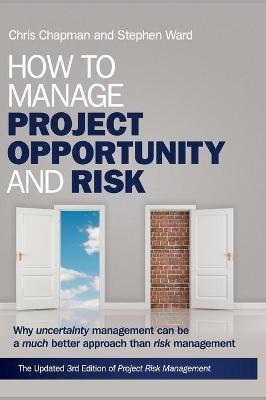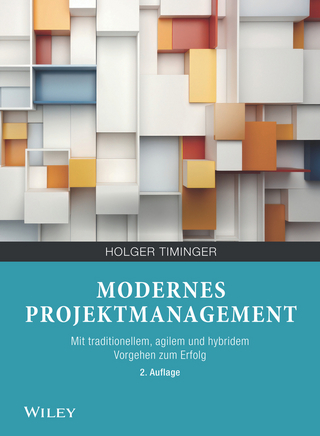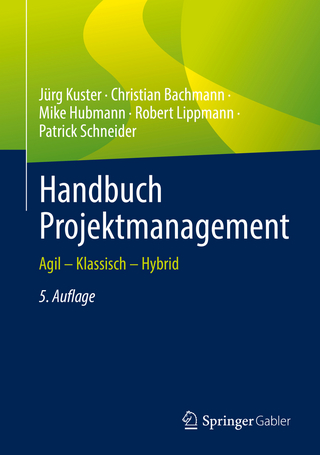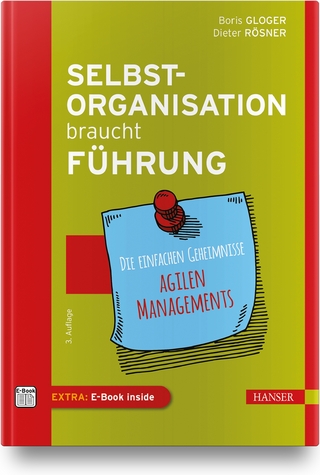
How to Manage Project Opportunity and Risk
John Wiley & Sons Inc (Verlag)
978-0-470-68649-2 (ISBN)
Since I wrote the Foreword for the second edition of this book, risk management processes have become much more widely used, but controversy about what should be done and how best to do it has grown. Managing risk is a risky business. Chapman and Ward provide an in-depth explanation of why it is important to understand and manage underlying uncertainty in all its forms, in order to realise opportunities more fully and enhance corporate performance. They show what best practice should look like. The implications go well beyond the conventional wisdom of project risk management, providing an enlightening new perspective.
—Professor Tony M. Ridley
Imperial College London, Past President, Institution of Civil Engineers Chris Chapman and Stephen Ward continue to educate the profession with this masterful exposition of the differences between, and the potentials for combinations of, risk, uncertainty and opportunity. Particularly welcome is the way they integrate this trio into the project lifecycle – the bedrock of project management control and organization.
—Peter W.G. Morris
Head of School and Professor of Construction and Project Management University College London
Chris Chapman and Stephen Ward’s books on Project Risk Management have been an essential part of my repertoire for twenty years, and they are top of my recommended reading for the courses I do on that subject. In this book they have enhanced their previous work to focus on uncertainty management and emphasise more strongly opportunities for improving project performance, rather then just identifying what can go wrong. A structured process is an essential part of managing project uncertainty, and their process is one of the most powerful. This book will be added to my repertoire.
—Rodney Turner
Professor of Project Management, SKEMA Business School Lille
A profoundly important book. With How to Manage Project Opportunity and Risk, Chris Chapman and Stephen Ward take a good thing and make it better. Members of the project management profession have been influenced for years by their insights into project risk management. With this latest instalment the authors demonstrate that risk and uncertainty needn’t be dreaded; in fact, the reverse side of the ‘risk coin’ has always been opportunity. My sincere appreciation to Chapman and Ward for turning this particular coin over and showing readers, academic and practitioner alike, the opportunity embedded in managing projects.
—Jeffrey K. Pinto
Andrew Morrow and Elizabeth Lee Black Chair in Management of Technology Sam and Irene Black School of Business, Penn State Erie
Stephen Ward is Professor of Management and Deputy Head in the School of Management, University of Southampton. For more than thirty years his teaching, research and consulting activities has focussed on risk and uncertainty management. He was founding Director of Southampton's MSc Programme in Risk Management. Stephen has served on the British Standards Institute Risk Management Committee, and is a Fellow of the UK Institute of Risk Management. Recent research funded by the UK Institution of Civil Engineers addressed operational risk in major infrastructure projects and businesses. Stephen has published widely, including authorship of Risk Management Organisation and Context (Witherby, 2005), and jointly with Chris, Managing Project Risk and Uncertainty: A Constructively Simple Approach to Decision Making (Wiley, 2002) and Project Risk Management: Processes, Techniques and Insights (Wiley, 1997 and 2003). Chris Chapman is Emeritus Professor of Management Science in the School of Management, University of Southampton. He is a former Director of the School. He was the founding chair of the Association for Project Management Specific Interest Group on Project Risk Management. He is a Past President of the Operational Research Society, and an Honorary Fellow of the Institute of Actuaries. For more than 35 years his research has focused on risk and uncertainty management. Like Stephen, his research is grounded on extensive experience. He has worked for a number of consulting firms as an international consultant for many different industries. Chris writes from a practical but conceptually rigorous perspective. He has published extensively, including joint authorship of Management for Engineers (Wiley, 1987), Risk Analysis for Large Projects: Models, Methods and Cases (Wiley, 1987), Managing Project Risk and Uncertainty: A Constructively Simple Approach to Decision Making (Wiley, 2002) and Project Risk Management: Processes, Techniques and Insights (Wiley, 1997 and 2003).
Foreword to this edition by Mike Nichols ix Foreword to the second edition with an update by Tony Ridley xi
Foreword to the fi rst edition by Peter Wakeling xiii
Preface and overview by the authors xv
Acknowledgements xxv
PART I Setting the scene 1
1 Uncertainty in and around projects 3
2 Uncertainty, risk and opportunity 43
3 Key motives for uncertainty management 73
4 An overview of generic process frameworks 101
PART II The generic process in one key lifecycle stage 131
5 Define the project 133
6 Focus the process 153
7 Identify all the relevant sources of uncertainty, response options and conditions 171
8 Structure all uncertainty 215
9 Clarify ownership 235
10 Quantify some uncertainty 251
11 Evaluate all the relevant implications 289
PART III The generic process in all lifecycle stages 325
12 Fully integrating the strategy shaping stages 327
13 Fully integrating the strategy implementation stages 365
PART IV Key corporate implications 389
14 Developing PUMP capability as a project 391
15 Contracts and governance as frameworks for enlightened relationship management 411
16 A corporate capability perspective 435
References 463
Glossary 473
Index 479
| Verlagsort | New York |
|---|---|
| Sprache | englisch |
| Maße | 175 x 252 mm |
| Gewicht | 1007 g |
| Themenwelt | Wirtschaft ► Betriebswirtschaft / Management ► Projektmanagement |
| ISBN-10 | 0-470-68649-9 / 0470686499 |
| ISBN-13 | 978-0-470-68649-2 / 9780470686492 |
| Zustand | Neuware |
| Haben Sie eine Frage zum Produkt? |
aus dem Bereich


